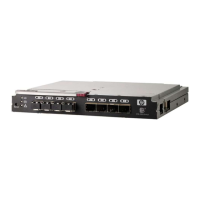Time Division Multiplexor (TDM). To overcome this limitation and provide support for frame-based
trunking with Extended Fabrics, Fabric OS 6.2.x and later has been enhanced to support interop-
erability with these distance extension devices.
Fabric OS 6.3.0 and later allows Extended Fabrics E_Ports to operate in VC_RDY mode using
either ARB or IDLE primitives as fill words. This allows frame-based trunking to be supported on
Extended Fabrics E_Ports even when IDLE primitives are configured for these ports when operating
in native VC_RDY mode. Prior to this change, frame-based trunking was supported only when ARB
primitives were used in VC_RDY mode. With Fabric OS 6.2.x, frame-based trunking is supported
on Extended Fabrics E_Ports even if IDLE or ARB primitives are used when operating in native
VC_RDY mode.
Implementation
The portcfglongdistance CLI parameter VC Translation Link Init is now overloaded
to specify whether the long-distance link should use IDLE or ARB primitives. By default vc_init is
enabled. When vc_init is enabled, the long-distance link uses ARB primitives. When vc_init is
disabled, the link uses IDLE primitives.
The buffer-to-buffer credit recovery feature is not supported on Extended Fabrics E_Port when it is
configured to use IDLE primitives. The user must disable the buffer-to-buffer credit recovery feature
using the portcfgcreditrecovery command and specifying the disable option; otherwise, the
link will continuously reset.
The Adaptive Networking SID/DID Traffic Prioritization QoS feature is not supported on Extended
Fabrics E_Ports when IDLE primitives are configured on these ports. In this mode, only data virtual
channels are available when QoS-related virtual channels are not available.
When connecting to an extension device that does not support ARB primitives (such as some TDM
products), the following configuration must be used:
• portcfgqos -disable <port>
• portcfgcreditrecovery –disable <port>
• portcfglongdistance <port><LD|LD>0<distance>
The fabric parameter fabric.ops.mode.longdistance is now deprecated and should not be
used.
8-Gb link initialization and fill words
This section describes the portCfgfillWord command that was first introduced in Fabric OS
6.2.0a.
Overview
The Fibre Channel Physical Interfaces (FC-PI) standard defines the requirements for a physical layer.
It considers all aspects of transmit, receive, and cable-plant performance requirements for optical and
electrical links. The FC-PI standard has been modified to support new physical-layer variants that
operate at higher data rates than those specified in FC-PI-2. The standard enables interoperability of
transmitter devices, receiver devices, interconnects, and components from different manufacturers.
New variants include support for a data rate of 800 MB/s. The previous implementation by Brocade
was to use Idles for link initialization and as fill words, which works for 1-Gb, 2-Gb, 4-Gb, and most
8-Gb devices. However, some of the new 8-Gb devices have problems with the Idle/Idle sequence
at 8 Gb. 8-Gb switches, HBAs, and smaller mid-range 8-Gb storage devices are using the Idle/Idle
sequences without any problems. Some of the new 8-Gb devices require that the ARB(FF)/ARB(FF)
sequence have successful link initialization. Brocade has developed an implementation of
HP StorageWorks Fabric OS 6.3.0c Release Notes 35

